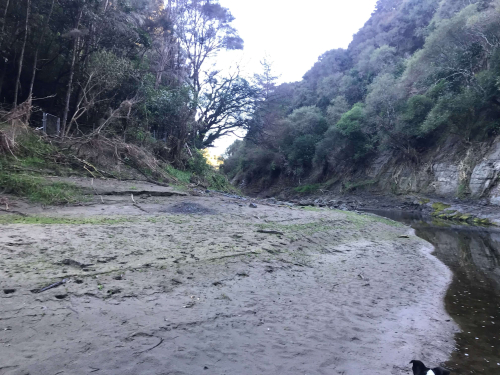
Sedges - hardy grass-like plants – are being planted along a stretch of the Okawa Stream at Crownthorpe by a group of local landowners. This project is a trial supported by Biodiversity Hawke’s Bay’s Environmental Enhancement Contestable Fund (EECF) to demonstrate the potential of these plants to stabilise stream banks and reduce weedy plant colonisation. The project is part of a wider programme of collaboration between local landowners, Hastings District Council (HDC) and Rūnanga whānau and hapū, designed to protect and enhance the biodiversity and conservation values of the catchment.
The focus area is the Okawa Stream Esplanade Reserve on Crownthorpe Settlement Road. This area is currently being restored to native forest through a combination of natural processes and active management by HDC. The Okawa Stream forms one of the Reserve boundaries, being the last stretch of the Okawa gorge under native forest cover before the stream opens up into pastoral farming land and flows on through to Ōmahu.
Cyclone Gabrielle mainly affected the lower banks of the Reserve boundary, sweeping away the dense blackberry and other plant pest cover, and removing some of the established silt banks that had built up over time. Following the damage, local landowners decided to proactively plant the stream margins, to help prevent further erosion and reduce the opportunity for blackberry and other weeds reestablishing in this zone. The group devised a trial planting of sedge species, with a focus on species that can withstand flood events and are less palatable to browsing by stock or feral animals. Another consideration was which species would thrive in each of the differing environments along the stream and gorge area. In time, it is hoped that the trial will also indicate what species could be planted downstream in the more open system, where the Cyclone wreaked havoc.
So far, the group have planted around 750 sedges - a mix of Cyperus ustulatus, Carex secta (Purei) and Carex virgata (Pukio). Since planting, regular monitoring and watering has been done, and the group have started removing weedy plants that are just now emerging from the silt. Group members report that the plants are looking good. It’s not an easy environment. Heavy rains in spring and feral deer passing through the gorge have damaged some of the new plants. But with over 80 Cyperus ustulatus plants held over from the initial planting, any gaps caused by the rain and deer will be filled this year. With a neighbouring farmer’s support, some may be planted further downstream to test how they perform outside the high-pressure flow of the gorge environment.
Many community members along the Crownthorpe Settlement Road stretch of the Okawa stream have a long history of native restoration activities, however 2023 was the first year they reached out to Biodiversity Hawke’s Bay for funding support. They chose to apply for the ‘small grants’ section of the EECF, utilising the fast application (shorted form) process available to groups starting out in funding and wanting only small contributions under $3,000. With the funds they purchased plants from Te Wai Mauri Trust’s nursery at Waiohiki.
“This is exactly the sort of community group and project that we had in mind when we established the ‘small project’ category for the 2023 grant round” says Biodiversity Hawke’s Bay GM Debbie Monahan. “The EECF funding is provided by Hawke’s Bay Regional Council, with Biodiversity Hawke’s Bay managing the application process. We are encouraging a wider range of groups and individuals to apply, including those just beginning a project or wanting to conduct a pilot that will test their restoration ideas.”
For Steph Howard, who’s been involved in the project, it is an opportunity to learn about an environment that is still changing after the Cyclone. “We’re really testing these species by planting at the end of the gorge where the flow pressure can be quite high, so plant species selection, spacing and protection from seasonal high-water flows are all important,” she says. It is also an opportunity to keep the community engaged. “The impact on some of the planting by feral deer was quite a blow initially – especially because it’s been such a tough year for native vegetation along the gorge. Yet it also shows how hardy the grasses are, as only a few were pulled out and most of those the deer munched are still alive because the root structure has developed so well. But it does reinforce that we, as a region, need to get on top of the feral deer population if we’re serious.”
“For us, the EECF has been great; the level of funding was perfect for this project, and it was a relief not to deal with an onerous application process for that amount. The community and Council supports a lot of the heavier-lifting, but this fund gave our community something to focus on when council budgets are so strained post Cyclone. It helps us keep up our motivation and enthusiasm, even while there’s much bigger work ahead”.
21 March 2024
Disclaimers and Copyright
While every endeavour has been taken by the Hawke's Bay Regional Council to ensure that the information on this website is
accurate and up to date, Hawke's Bay Regional Council shall not be liable for any loss suffered through the use, directly or indirectly, of information on this website. Information contained has been assembled in good faith.
Some of the information available in this site is from the New Zealand Public domain and supplied by relevant
government agencies. Hawke's Bay Regional Council cannot accept any liability for its accuracy or content.
Portions of the information and material on this site, including data, pages, documents, online
graphics and images are protected by copyright, unless specifically notified to the contrary. Externally sourced
information or material is copyright to the respective provider.
© Hawke's Bay Regional Council - www.biodiversityhb.org / 027 231 9367 / info@biodiversityhb.nz